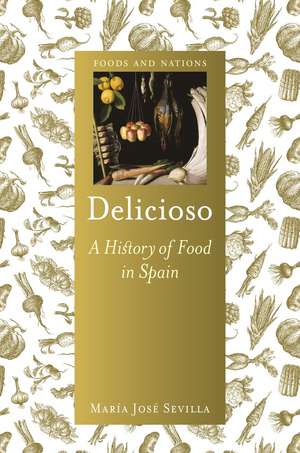Delicioso: A History of Food in Spain: Foods and Nations
Autor María José Sevillaen Limba Engleză Hardback – 15 dec 2019
Spanish cuisine is a melting-pot of cultures, flavors, and ingredients: Greek and Roman; Jewish, Moorish, and Middle Eastern. It has been enriched by Spanish climate, geology, and spectacular topography, which have encouraged a variety of regional food traditions and “Cocinas,” such as Basque, Galician, Castilian, Andalusian, and Catalan. It has been shaped by the country’s complex history, as foreign occupations brought religious and cultural influences that determined what people ate and still eat. And it has continually evolved with the arrival of new ideas and foodstuffs from Italy, France, and the Americas, including cocoa, potatoes, tomatoes, beans, and chili peppers. Having become a powerhouse of creativity and innovation in recent decades, Spanish cuisine has placed itself among the best in the world.
This is the first book in English to trace the history of the food of Spain from antiquity to the present day. From the use of pork fat and olive oil to the Spanish passion for eggplants and pomegranates, María José Sevilla skillfully weaves together the history of Spanish cuisine, the circumstances affecting its development and characteristics, and the country’s changing relationship to food and cookery.
This is the first book in English to trace the history of the food of Spain from antiquity to the present day. From the use of pork fat and olive oil to the Spanish passion for eggplants and pomegranates, María José Sevilla skillfully weaves together the history of Spanish cuisine, the circumstances affecting its development and characteristics, and the country’s changing relationship to food and cookery.
Preț: 180.71 lei
Preț vechi: 218.91 lei
-17% Nou
Puncte Express: 271
Preț estimativ în valută:
34.58€ • 35.68$ • 29.27£
34.58€ • 35.68$ • 29.27£
Carte disponibilă
Livrare economică 12-19 februarie
Livrare express 28 ianuarie-01 februarie pentru 90.62 lei
Preluare comenzi: 021 569.72.76
Specificații
ISBN-13: 9781789141375
ISBN-10: 1789141370
Pagini: 344
Ilustrații: 80 color plates, 20 halftones
Dimensiuni: 152 x 235 x 28 mm
Greutate: 0.97 kg
Ediția:1
Editura: REAKTION BOOKS
Colecția Reaktion Books
Seria Foods and Nations
ISBN-10: 1789141370
Pagini: 344
Ilustrații: 80 color plates, 20 halftones
Dimensiuni: 152 x 235 x 28 mm
Greutate: 0.97 kg
Ediția:1
Editura: REAKTION BOOKS
Colecția Reaktion Books
Seria Foods and Nations
Notă biografică
María José Sevilla is the author of Life and Food in the Basque Country, Spain on a Plate, and Mediterranean Flavours, among other books. She lives in London.
Recenzii
"In the past two decades, the reputation of Spanish food on the world’s culinary stage has skyrocketed, with chefs like Ferran Adrià, the Roca brothers, the Arzaks and José Andrés in the lead. But as Delicioso, a new history of Spanish food explains, it is not a sudden phenomenon. The illustrated book is a dense, scholarly survey that starts with prehistory some 80,000 years ago. It traces the contributions to the Spanish table by ancient Rome; Moorish, Christian and Jewish cultures; European royalty; and foods of the New World. The effects of social and political change, years of war and the rise of the influential Spanish chefs of today are covered, as are ingredients like olives, anchovies and chocolate; markets; dishes like cocido; and time-honored utensils. There’s a quick survey of food across Spain, region by region."
Won
"Sevilla’s history of Spain and surrounding islands through edibles incorporates cooking into an exacting cultural overview. From the Celtic origins of Iberia, initial chapters examine early settlement through 1492, menu by menu. With a burst of specifics, the history of the Columbian exchange accompanies growth of the salt cod industry and worldwide pepper and saffron trades. By examining Jewish, Moorish, and Islamic immigrants and their tastes, the text accounts for a complex diet rich in flavors and aromas, from pulses, moles, lenten eggs and beans, and gazpacho to lamb and anchovy grills, tartas, and manchego cheese. Meticulous footnotes and bibliography precede primary and secondary indexing that points the way to the stews and bitter oranges of Andaluz, Castilian black pudding and roast meats, the mozdrabe cuisine of Cordoba, and periods of starvation during World War II and the Spanish Civil War. Memorable passages treating individual foods—potatoes, sugar, tomatoes, chocolate, rice—epitomize the Spanish skill at incorporating newcomers to the marketplace in piquant fritters, omelets, marzipan, and restaurant tapas . . . A prize for the culinary section of public, high school, or college libraries. Highly recommended."
"Like other works of art, dishes document culture. Sevilla shows us that the best way to enjoy Spanish history is by eating Spanish food, and that the best way to enjoy the food is by reading her account of the history. ¡Buen provecho!"
"An epic and very readable history of Spanish food culture from Palaeolithic times to the present day. Excellent and very interesting."








